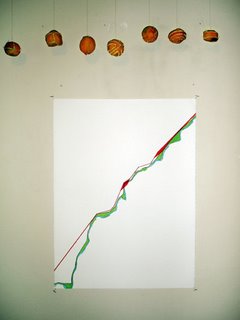Last Summer Projects

Here's a quick photo of some current projects. The oranges for the "Smorgasbord" Exibition and then a new piece for another show, "Remnants From Passage," curated by MFA student, Thea Eck. This is a brief description of the exhibit:
"How does the landscape record diverse acts and events of human activity? For example: desolate landscapes of war-town houses in Sudan compared with aerial views of past expedition encampments in the Arctic, both recording a human imprint yet no longer inhabited. Such contemporary or historic records may reference a passage of negotiated borders and resources. What can we glean from the traces of our activities that are left behind? How are they deciphered and then re-contextualized over time?
What is the relationship between our shifting identities to the landscape and the tools we use to record them?"
I decided to do an abstracted drawing of my commute to work in the national park. It's a 12-mile stretch of state highway that parallels the Skagit River. Also running next to the road are two sets of powerlines that travel from three hydroelectric dams to Seattle. I was curious of the form and the interplay between these three elements, reduced to lines from an ariel perpective. The blue is the Skagit river, the green is the land between the highway and the river, and the red is the space between the two powerlines. Even though they both travel in the same direction, the lines go from an organic quality (the river) to linear and man-made (the powerlines), with the road being a combination of the two. I'm also curious which element would last the longest. It's tempting to believe that nature will eventually reclaim all of man's "intrusions," but since the river is fed by glaciers within the park, and since humans are currently escalating the rate at which the glaciers melt, it may be possible that the river disappears first. (Of course, since the powerlines carry electricity generated from the river, that could be the next to go). Interesting questions to ponder. I'd enjoy exploring this process of abstracting landscapes and maps further...

0 Comments:
Post a Comment
Subscribe to Post Comments [Atom]
<< Home